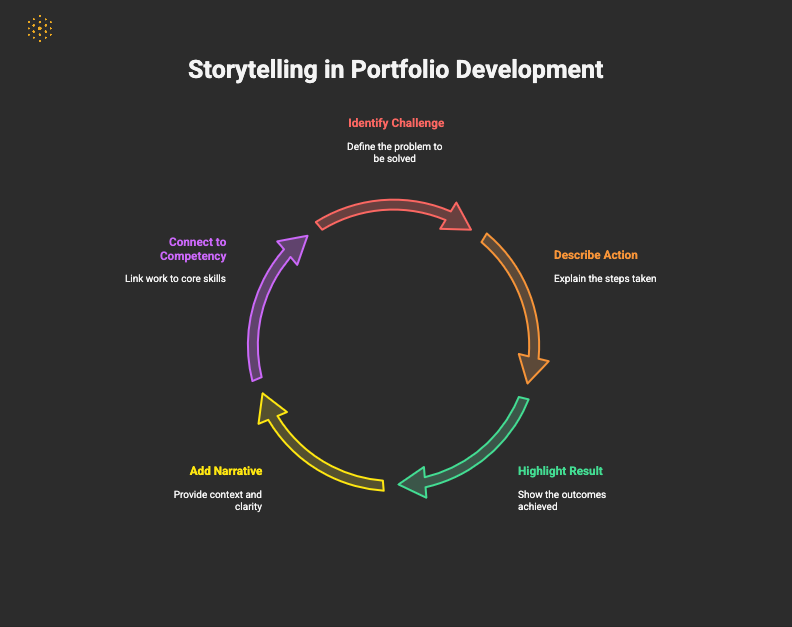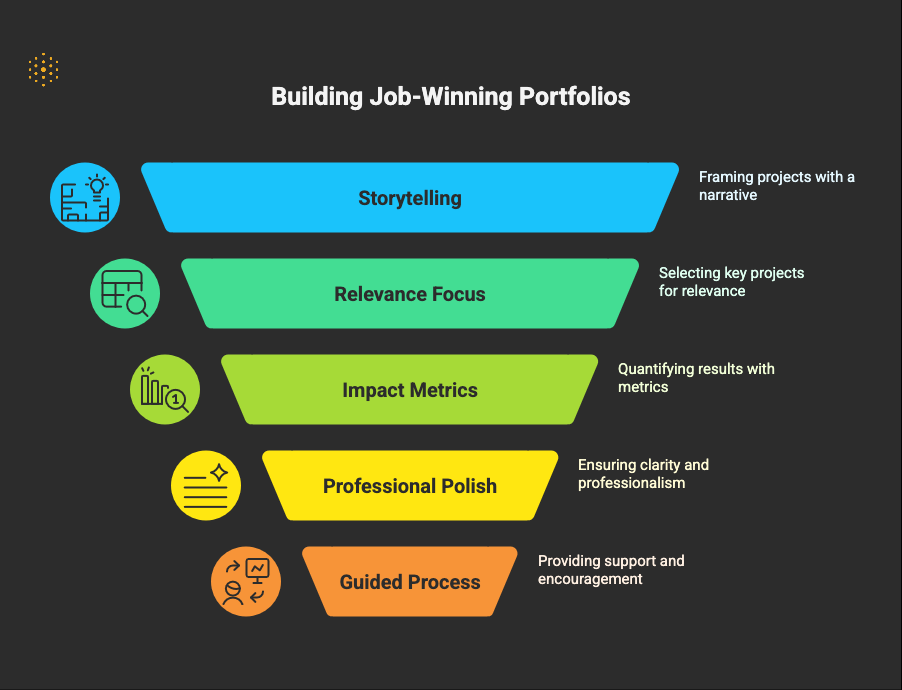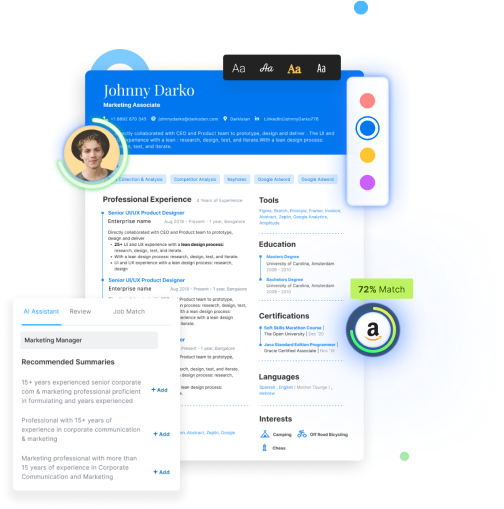How should career counselors guide students to build job-winning portfolios?
Guide students to frame projects with challenge, action, result, select 3-5 relevant works, and quantify outcomes. Keep portfolios concise, polished, and current, and support progress with phased milestones and constructive feedback.
More than 72% of employers say a portfolio can sway their hiring decision and nearly 60% actively prefer it over a resume alone.
As a career counselor, that’s your cue.
Portfolios aren’t just for art or design anymore - they’re becoming essential in fields like business, tech, journalism, and marketing.
Whether students are applying for internships, jobs, or grad school, a portfolio gives them the chance to prove their skills through real work.
So, how can you help students turn class projects, internships, and personal work into job-winning proof of potential?
Here are 5 best practices you can follow to help them build job-winning portfolios with clarity, confidence, and impact.
1. Teach the Power of Storytelling
Portfolios shouldn’t be a collection of disconnected artifacts. Help students frame each project around a clear story:
- Challenge: What problem were they solving?
- Action: What did they do?
- Result: What changed or improved?
This structure helps employers understand how a student thinks, not just what they made. Encourage students to add 2-3 lines of narrative per project to provide context and clarity.
At San José State University’s iSchool, students are trained to frame their work through reflective narratives as part of their e-portfolio capstone.
Each entry includes a written explanation that connects the work to a core competency, adding both depth and clarity.
A portfolio entry like “Redesigned a student website to improve event signups - traffic increased by 25% in two weeks” is far more effective than “Website project.”
Also Read: What are some of the best practices for setting up virtual career treks?

2. Focus on Relevance, Not Volume
More isn’t better. Help students select 3-5 of their strongest, most relevant projects, rather than filling the portfolio with every class assignment. Ask them:
- What kinds of roles are you applying to?
- Which projects best show those skills?
A marketing student might highlight a social media campaign, while a data student might showcase a dashboard or analysis project. It’s about aligning their content to the job they want, just like with resumes.
This approach is echoed at Wesleyan University’s Gordon Career Center, where students are guided to tailor their portfolio content with the same intent as a targeted resume - cutting out filler and emphasizing the experiences that match the employer’s needs.
Also Read: How is Hiration a better Big Interview alternative?
3. Highlight Impact with Metrics
Employers want to see results - not just effort. That means students should quantify their impact wherever possible:
- “Boosted engagement by 2,000% in six weeks”
- “Reduced response time by 30% with automated workflow”
- “Presented analysis that led to new marketing strategy”
San José State students are encouraged to pair every project with evidence of results, from adoption rates to faculty feedback.
A student who developed a prototype later used by three real-world clients didn’t just showcase the product - she highlighted its downstream value, which left a lasting impression.
Also Read: How is Hiration better than VMock?
4. Keep It Clean, Professional, and Up to Date
A strong portfolio should be:
- Concise: Easy to skim, no fluff
- Polished: No typos, consistent formatting, functioning links
- Current: Updated every few months, especially when actively job-seeking
Advise your students to test their portfolio across devices to ensure mobile responsiveness and avoid broken visuals or links.
At Nebraska Wesleyan University, digital portfolios are embedded into the curriculum. Students are required to review their portfolios across devices for formatting issues, test for mobile responsiveness, and proofread meticulously.
This attention to professionalism reinforces the idea that the portfolio isn’t just creative expression, it’s a living extension of a candidate’s brand.
Also Read: How to boost student engagement in career treks?
5. Make It a Guided, Encouraging Process
Portfolio building can feel overwhelming, especially for students who think they don’t have “real” experience. Counselors can make the process less intimidating by:
- Breaking it into phases: bio this week, project uploads next
- Framing feedback with “Glow and Grow”: praise first, then guide
- Sharing examples of peer success to inspire confidence
- Using reflection prompts like “What are you most proud of?” to help students uncover value in their academic journey
Wesleyan University’s CSPL 405 course offers a great model: students build their portfolio over a series of weekly prompts and milestones, supported by faculty and peers.
It’s not just a technical process, it’s one of identity formation. When students feel supported, they’re more likely to take ownership, experiment, and refine their work.
Also Read: What are some coaching models for career centers?

Final Thoughts
Strong portfolios give students the clarity and confidence to show what they’re capable of, and that’s often what makes the difference.
If you’re looking to extend that support without stretching your team, Hiration is built to help.
We're already helping 100+ colleges like NYU Stern and CSU Fullerton, boost outcomes with AI-powered resumes, interview prep, and round-the-clock chat based career assistance.
Curious to see how it could support your students too? Let’s set up a quick walkthrough!
Frequently Asked Questions
-
Why should students build a portfolio in addition to a resume?
More than 72% of employers say a portfolio can sway their hiring decision and nearly 60% actively prefer it over a resume alone. It gives students the chance to prove their skills through real work.
-
Which fields benefit from student portfolios?
Portfolios aren’t just for art or design; they’re becoming essential in fields like business, tech, journalism, and marketing.
-
How should you structure a project entry in a student portfolio?
Frame each project around a clear story using Challenge, Action, and Result, and add 2-3 lines of narrative per project to provide context and clarity.
-
How many projects should a student include in a portfolio?
Select 3-5 of your strongest, most relevant projects. Align them with the kinds of roles you’re applying to.
-
How do you highlight impact in a portfolio?
Quantify results with metrics and evidence. For example, “Boosted engagement by 2,000% in six weeks” or “Reduced response time by 30% with automated workflow”.
-
What common portfolio mistakes should students avoid?
Avoid overloading it, since “More isn’t better.” Keep it polished with no typos, consistent formatting, and functioning links.
-
How often should students update a portfolio?
Update it every few months, especially when actively job-seeking. Review it across devices to ensure mobile responsiveness.
-
How can you ensure a portfolio looks professional?
Keep it concise, polished, and current. Test across devices to ensure mobile responsiveness and avoid broken visuals or links.
-
How can counselors make portfolio building less intimidating?
Break it into phases, frame feedback with “Glow and Grow,” share examples, and use reflection prompts like “What are you most proud of?”
-
Should portfolios only be for creative fields?
No. They’re becoming essential in fields like business, tech, journalism, and marketing.



